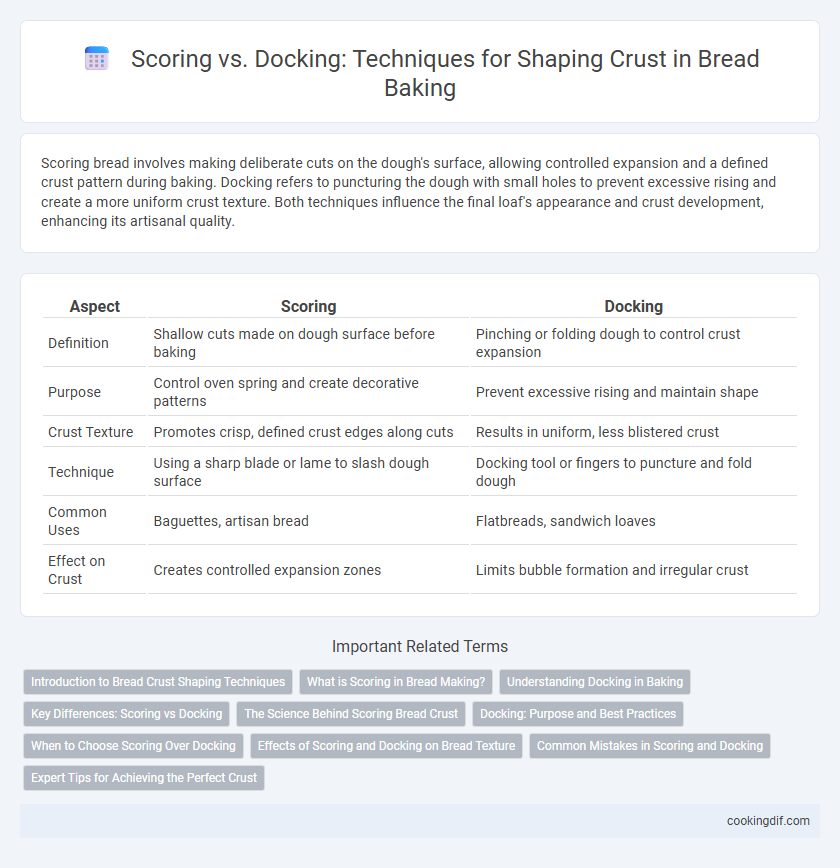Scoring bread involves making deliberate cuts on the dough's surface, allowing controlled expansion and a defined crust pattern during baking. Docking refers to puncturing the dough with small holes to prevent excessive rising and create a more uniform crust texture. Both techniques influence the final loaf's appearance and crust development, enhancing its artisanal quality.
Table of Comparison
| Aspect | Scoring | Docking |
|---|---|---|
| Definition | Shallow cuts made on dough surface before baking | Pinching or folding dough to control crust expansion |
| Purpose | Control oven spring and create decorative patterns | Prevent excessive rising and maintain shape |
| Crust Texture | Promotes crisp, defined crust edges along cuts | Results in uniform, less blistered crust |
| Technique | Using a sharp blade or lame to slash dough surface | Docking tool or fingers to puncture and fold dough |
| Common Uses | Baguettes, artisan bread | Flatbreads, sandwich loaves |
| Effect on Crust | Creates controlled expansion zones | Limits bubble formation and irregular crust |
Introduction to Bread Crust Shaping Techniques
Scoring bread involves making precise cuts on the dough surface, allowing controlled expansion and creating decorative patterns that enhance crust texture. Docking uses a tool to perforate the dough, preventing large air bubbles and resulting in a uniform crust without dramatic oven spring. Both techniques significantly influence the final appearance and texture of the bread crust, affecting moisture retention and caramelization during baking.
What is Scoring in Bread Making?
Scoring in bread making involves making shallow cuts on the dough's surface before baking, allowing controlled expansion and preventing undesirable cracking. This technique influences the crust's texture and appearance, contributing to a more artisanal look and improved oven spring. Unlike docking, which perforates the dough to inhibit rising, scoring guides the bread's natural expansion during baking.
Understanding Docking in Baking
Docking in baking involves piercing the dough with a tool to prevent excessive rising and uneven crust formation, ensuring a consistent texture and appearance. This technique controls gas expansion during baking, which helps maintain the desired shape and prevents large air pockets or bubbles in the bread crust. Docking proves essential for achieving a uniform, flat crust, especially in flatbreads and pie crusts, by allowing steam to escape and avoiding over-inflation.
Key Differences: Scoring vs Docking
Scoring and docking are critical techniques in bread shaping that influence crust texture and appearance. Scoring creates deliberate surface cuts that control oven spring, allowing the dough to expand without tearing and resulting in a crisp, decorative crust. Docking involves perforating the dough with small holes to prevent excessive rise and bubbling, producing a more uniform, flatter crust.
The Science Behind Scoring Bread Crust
Scoring bread crust creates controlled expansion points, preventing random bursting while enhancing oven spring by directing gas release during baking. This technique influences crust thickness, texture, and caramelization by exposing dough surface areas to the oven's heat, promoting Maillard reactions. In contrast, docking uses small, uniform perforations to reduce air pockets and ensure even baking without dramatic crust shaping or expansion.
Docking: Purpose and Best Practices
Docking bread involves making small, deliberate holes on the dough surface to prevent uneven rising and large air pockets during baking, ensuring a uniform crust. Its purpose is to control dough expansion and create an even, flat bread surface, especially in flatbreads and pizza crusts. Best practices include using a dough docker or fork with consistent spacing and depth to maintain proper airflow and crust texture.
When to Choose Scoring Over Docking
Scoring bread dough creates controlled expansion during baking, ensuring an artisanal crust with distinctive patterns and improved oven spring. This technique is ideal for high-hydration doughs where dramatic rise and crust texture are desired. Docking, which involves puncturing the dough surface multiple times, is better suited for thinner doughs or flatbreads to prevent excessive puffing and maintain even thickness.
Effects of Scoring and Docking on Bread Texture
Scoring bread creates controlled steam release points, resulting in a crust with distinct ridges and a crispy texture, while docking prevents excessive rising and produces a flatter, more uniform crust. The depth and pattern of scoring influence oven spring and crumb structure, enhancing aeration and crust thickness. Docking minimizes large air pockets, promoting an even crumb and a softer outer layer, ideal for breads requiring a tender bite.
Common Mistakes in Scoring and Docking
Common mistakes in scoring bread dough include making cuts that are too shallow or too deep, which can hinder proper oven spring and lead to uneven crust development. Docking errors often involve over-docking, causing excessive steam release and a dense crumb, or under-docking, resulting in large bubbles and irregular shapes. Proper scoring with consistent depth and strategic docking patterns ensures optimal crust texture and controlled expansion during baking.
Expert Tips for Achieving the Perfect Crust
Scoring bread with a sharp blade creates controlled expansion during baking, resulting in a crisp, artisan-style crust with attractive patterns. Docking, which involves pricking the dough with a tool or fork, prevents large air pockets and creates a more uniform, thinner crust ideal for flatbreads and crackers. Expert bakers recommend scoring for rustic loaves to enhance oven spring, while docking suits delicate doughs that require even cooking and minimal rise.
Scoring vs Docking for shaping crust Infographic

 cookingdif.com
cookingdif.com